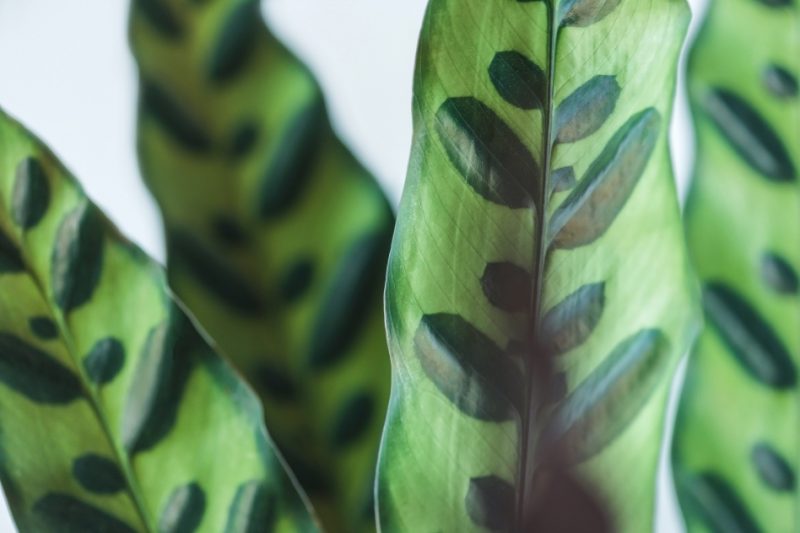The Calathea Lancifolia is a home favorite because of its beautiful lance-shaped leaves with their offsetting purple undersides. A bright green canopy serves as the perfect backdrop to deep green ovals, making this one of the most popular houseplants.
This native Brazilian rainforest plant also goes by the name Rattlesnake Plant because of its appearance. However, it is much more welcome in a household than the reptile it’s named after. It’s not even toxic so there’s nothing to worry about with pets and children.
Calathea Lancifolia Watering Guide
Being a tropical plant means that the Calathea Lancifolia requires a lot of water in order to thrive. The soil must always be kept damp. If the soil dries out, the health of this plant will suffer. So you should feel the soil every day to make sure it’s damp. If the top layer is dried out, then you should water it.
Apply water slowly until it starts to seep from the drainage holes in the bottom of the pot. Then empty the drainage container. Just be careful not to oversaturate the soil with water because it will cause the roots to rot. Plus you open it up to pests.
Soil Requirements
Calathea Lancifolia requires soil to be moist but not over-saturated. However, the soil must also be packed with nutrients so it can thrive.
Use a soil that is rich in peat and mixed together with vermiculite and perlite. This should ensure that the soil drains well and doesn’t become over-saturated when you water it.

Feeding the Calathea Lancifolia
Calathea Lancifolia requires a specific feeding regimen. Use a well-balanced fertilizer that is capable of being diluted in water so that you can introduce it while watering the plant.
That said, only feed the Calathea Lancifolia during the spring, summer, and fall months. Do not feed it during the winter when it’s dormant.
Repotting the Calathea Lancifolia
If the rattlesnake plant stops growing over an extended period of time, you might need to replant it. The reason is because the roots simply don’t have enough room to spread out. So if you want the plant to get larger, you’ll have to repot it.
Upgrade the pot by a couple of sizes and ensure that it has drainage holes in the bottom. Then use the exact same mixture of soil as the plant’s current environment and test the new soil’s pH level before moving it. The pH level must be roughly the same as the current soil.
Gently lift the plant from the soil and remove excess soil from the roots before placing it into the new pot.
Humidity and Environmental Requirements
Since the Calathea Lancifolia is native to rainforests in South America, they are accustomed for a high humidity environment. So if you want it to thrive in your home, you’ll have to simulate its high humidity habitat. There are some tricks to get you going though.
The first method involves simply misting the plant with water using a spray bottle. But this requires you to watch it too closely.
With that said, the best method of creating a humid environment for your plant is to place a tray with small stones and water underneath it. The pot itself shouldn’t touch the tray. What this does is ensures that the water is evaporated upward through the plant, thereby creating humidity.
How Big Can the Rattlesnake Plant Get?
The Calathea Lancifolia can reach as high as 30 inches if grown outdoors but you can limit this growth indoors. Its intricate design also makes it a great choice for decorating the outside of your home. However, this plant can only be grown in states where freezing isn’t an issue.
With that said, the Calathea Lancifolia is a popular houseplant that most people choose to have inside. Potting the plant limits its growth to about 12-18 inches.
Light Requirements
If the Calathea Lancifolia gets too much direct sunlight, it will start to show signs of being damaged. The spots will fade and the colors will become duller than normal. So you need to make sure your plant isn’t in a window with direct sunlight in the afternoon. Morning sunlight is perfect so if you have an eastern window, that would be ideal.
You can also place it near a window that has drapes. Just be sure to pull the drapes open for an hour or so every day and then keep them closed the rest of the day.
Feeding the Calathea Rattlesnake
This amazingly beautiful houseplant enjoys to be fed every month during seasons of high growth. Spring and summer are usually the two months that require feeding but in some areas it could carry over into other months depending on the climate.
A balanced liquid fertilizer is this plant’s favorite. It will repay your kindness by sprouting healthy foliage. You can also use a very small amount of nitrogen fertilizer but you have to be very careful or you can damage the plant.

Calathea Lancifolia Propagating Guide
The Calathea Lancifolia can be repotted in the spring or summer seasons when growth is at its highest rate. Do not try propagating the Calathea Lancifolia in the winter or late fall.
Since this plant has sensitive roots, you have to be gentle. It creates its own natural separations so propagation is easy. Just be gentle because the roots are easily damaged.
Once you have removed a section of the plant, place it into a new pot with fresh soil. Keep these divisions warm and humid so they can latch onto the new soil and grow.
Additional Care Tips for the Calathea Lancifolia
One of the first tips for the Calathea Lancifolia is to make sure you repot it every couple of years. However, only increase the pot size by two inches each time to avoid having too much soil in the pot. Here are some additional care tips:
- Clean the leaves occasionally to remove accumulated dust. This dust is a magnet for pests so cleaning the Calathea Lancifolia is an essential pest prevention method.
- If leaves start to turn brown, then either the plant has too much salt or the air is too dry. Be sure that you check the humidity during the winter to make sure the environment is good.
- Salt accumulation can be a huge issue for the Calathea Lancifolia so you need to take steps to flush away these harmful salts. You’ll notice that the top layer of soil will accumulate a crusty, white material if you don’t flush the soil. Add room temperature distilled water to the soil and allow it to drain from the holes in the bottom of the pot. Then add more water to flush slowly flush the salt from the soil.
Final Thoughts
If you’re interested in adding this beautiful houseplant to your collection, then be sure you understand the steps required for its care. While it’s not the most difficult plant to care for, it will suffer is its basic needs are not met. Keeping a consistent watering schedule and checking the soil for white crusty buildup is essential to its health.
With the help of this guide, you should be able to successfully grow this beautiful plant and start gaining the benefits immediately.






Leave a reply